

Dr. Joseph Trivisonno
K-12 Supervisor of Mathematics, Science and STEM Programs
PBISWorld.com Home Page. Free Online Textbooks, Flashcards, Practice, Real World Examples, Simulations. What makes a good question? Teachers ask thousands of questions each week.

They are the prime means of finding out what pupils think and to get them to think in the first place. And there are a range of techniques you can use to develop questioning skills. Here are five ways to avoid that frustrating situation in which you ask a question and receive absolutely no response: Avoid questions that require a single, direct answer, such as: “What is the capital of Mongolia?”
Discussion Toolkit. The Whole Class Feedback Guide. Tools for educators / Problems of the month The Problems of the Month are non-routine math problems designed to be used schoolwide to promote a problem-solving theme at your school.

Each problem is divided into five levels of difficulty, Level A (primary) through Level E (high school), to allow access and scaffolding for students into different aspects of the problem and to stretch students to go deeper into mathematical complexity. Explore the Problems of the Month here. performance assessment tasks. Internet Digital Resources for Teachers. Mosaic: An Integrated Approach to Mathematics, Science, Technology, & Language. Mosaic is a K–5 supplemental instructional program that provides engaging and rigorous lessons and resources that integrate math, science, and technology while supporting English learners and academic language skills.
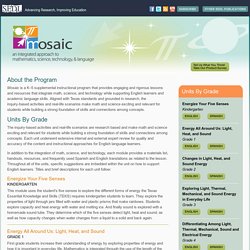
STEM - Additional STEM Resources. STEM%20Activities%20Handbook.pdf. Untitled. Challenge Toolkit.
FREE Summer Math Program. Developing Questions for Critical Thinking. “Education must be increasingly concerned about the fullest development of all children and youth, and it will be the responsibility of the schools to seek learning conditions which will enable each individual to reach the highest level of learning possible.”
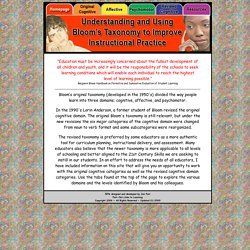
Benjamin Bloom Handbook on Formative and Summative Evaluation of Student Learning Bloom’s original taxonomy (developed in the 1950's) divided the way people learn into three domains: cognitive, affective, and psychomotor. In the 1990's Lorin Anderson, a former student of Bloom revised the original cognitive domain. The original Bloom's taxonomy is still relevant, but under the new revisions the six major categories of the cognitive domain were changed from noun to verb format and some subcategories were reorganized. The revised taxonomy is preferred by some educators as a more authentic tool for curriculum planning, instructional delivery, and assessment. Using Student Growth Percentiles. Welcome to Math Playground. Play with numbers and give your brain a workout!
Formative Assessment - Eric Milou. Formative assessment. 70Formative Assess Strategies jv.pdf. 03 - Formative Assessment Strategies.pdf. 60FormativeAssessment.pdf. Examples of Formative Assessment. When incorporated into classroom practice, the formative assessment process provides information needed to adjust teaching and learning while they are still happening.

Www.lasalle.edu/~beatty/310/ACES_CD/editing_and_writing/accuracy_and_fairness/Mathmistakes.pdf. Book%20Two%20Natalie%20Regier.pdf. Dipsticks: Efficient Ways to Check for Understanding. What strategy can double student learning gains? According to 250 empirical studies, the answer is formative assessment, defined by Bill Younglove as "the frequent, interactive checking of student progress and understanding in order to identify learning needs and adjust teaching appropriately. " Unlike summative assessment, which evaluates student learning according to a benchmark, formative assessment monitors student understanding so that kids are always aware of their academic strengths and learning gaps. Meanwhile, teachers can improve the effectiveness of their instruction, re-teaching if necessary.
"When the cook tastes the soup," writes Robert E. Stake, "that's formative; when the guests taste the soup, that's summative. " Www.edutopia.org/pdfs/blogs/edutopia-finley-53ways-check-for-understanding.pdf. Parent Roadmaps to Common Core Standards / Parent Roadmaps- Mathematics. Math2.org. HOME - Math Regents Exams Integrated Algebra, Geometry, Trigonometry worksheets answers lesson plans ExamView resources. We provide teachers and students with mathematics relevant to our world today …
Illustrated Mathematics Dictionary. Mathwords. A+ Click Math Problems and Logic Puzzles for Grade K-1 K-12. Illustrative Mathematics. Www.act.org/compass/sample/pdf/numerical.pdf. New Jersey Educator Resource Exchange. Eric Milou. LearnZillion. GeoGebra. Standards for Mathematical Practice. "Does this make sense?
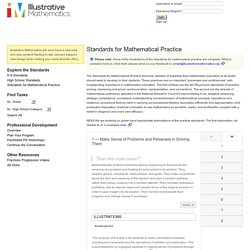
" Mathematically proficient students start by explaining to themselves the meaning of a problem and looking for entry points to its solution. They analyze givens, constraints, relationships, and goals. DCHS ACT Math Question of the Day. Env Math Scope & Sequence. Dashboard. Common Core Math. Common Core / PARCC. High Frequency words by frequency. Model Curriculum: Mathematics (K-12) Mathematics (K-12) REVISED Model Curriculum – June 2014 The model curriculum is intended as a tool to support districts in their own curricular planning.
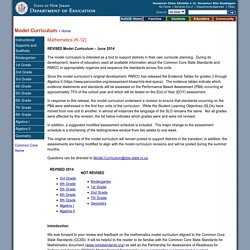
PARCC Math by Standard.pdf. PARCC Games. Regents Prep Center Integrated ALGEBRA (Algebra 1) CCSS Library. Mathematics - Mathematics. Response to Intervention. PARCC Resources & Practice. Brain Teasers. Sliding Triangle The triangle at left lies on a flat surface and is pushed at the top vertex.
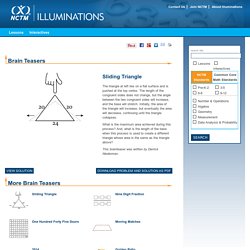
The length of the congruent sides does not change, but the angle between the two congruent sides will increase, and the base will stretch. Initially, the area of the triangle will increase, but eventually the area will decrease, continuing until the triangle collapses.